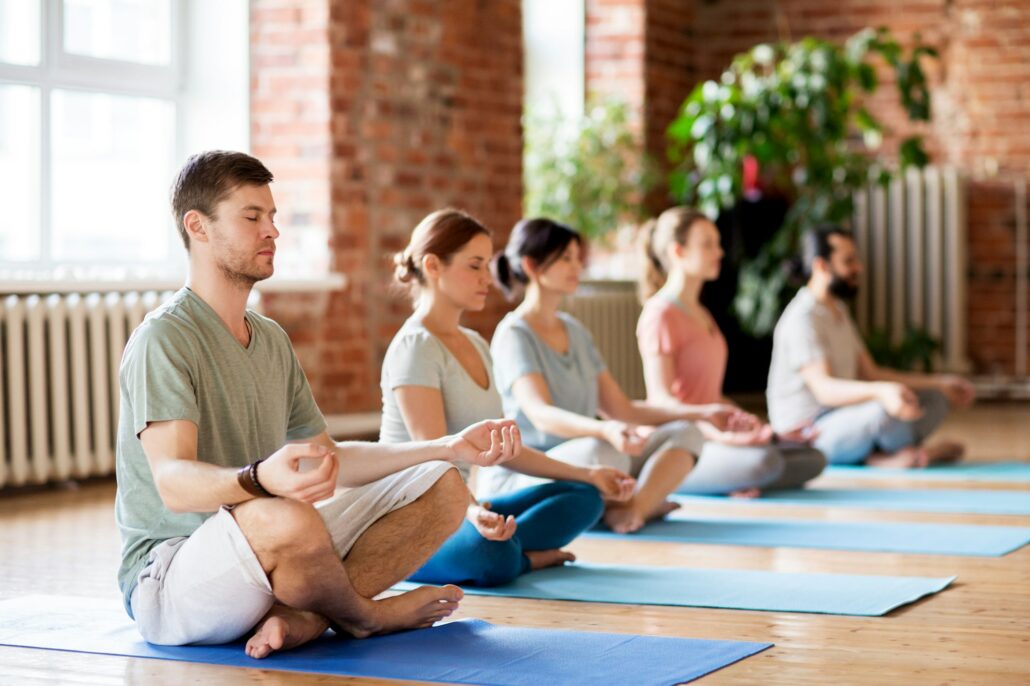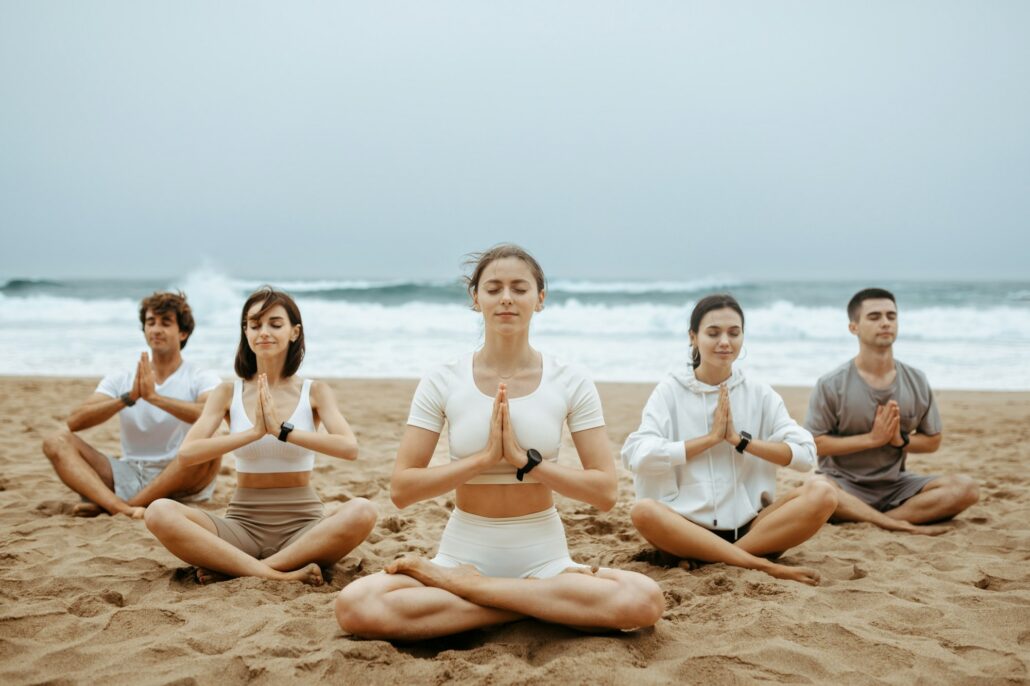Mindfulness Ruhevolles Gewahrsein
Schritt-für-Schritt Meditation
Vorbereitungsphase

Den Geist, den Körper und den Fokus entspannen
1) Setze dich entspannt mit geradem Rücken hin und atme ganz natürlich.
2) Entspanne die Muskeln deines Körpers.
3) Spüre deinen Geist wie einen angespannten Muskel – und entspanne ihn.
4) Lasse allen Fokus los, sei absichtslos und entspanne dich.
5) Verweile in diesem unfokussierten, entspannten Zustand.
6) Wenn du fertig bist, nimm dir eine Minute Zeit, um langsam wieder zurückzukehren.
Diese Meditation konzentriert sich darauf, Körper und Geist tief zu entspannen, ohne sich auf etwas Bestimmtes zu fokussieren. Eine zentrale Idee ist, den Geist wie einen Muskel zu empfinden – so wie die Muskeln im Körper. Wenn dieser „Geistesmuskel“ angespannt ist – etwa durch Grübeln oder Verwirrung –, verwendet er Energie und verursacht Stress. Im Alltag springt unsere Aufmerksamkeit gewöhnlich von einem Objekt zum nächsten, was diesen Geistesmuskel angespannt und beschäftigt hält.
Ziel dieser Praxis ist es, zu lernen, diesen Geistesmuskel vollständig zu entspannen – so wie man die körperlichen Muskeln nach Anspannung loslässt. Man beginnt aufrecht sitzend mit einem entspannten Körper und natürlicher Atmung, wodurch man bereit wird, die Spannungen in Körper und Geist wahrzunehmen.
Dann entspannt man bewusst die körperliche Spannung und – noch wichtiger – man spürt die Spannung im Geist wie einen Muskel und lässt sie schmelzen – wie Eis, das zu Wasser wird, herabfließt und die Erde berührt. Wenn sich der Geistesmuskel entspannt, entspannt sich auch der ganze Körper noch tiefer.
Im nächsten Schritt lässt man den Fokus vollständig los und erlaubt der Aufmerksamkeit, sich zu weiten in einen Zustand offener, ungerichteter Achtsamkeit. Nichts wird hervorgehoben oder festgehalten, und der Geist ruht in vollständiger Entspannung. Dieser ungerichtete Zustand ist stabil und ruhig, frei von Flackern oder Ablenkung.
Wenn die Sitzung endet, kehrt man sanft innerhalb etwa einer Minute zurück und bewahrt dabei das Gefühl von Ruhe und Entspannung, während man sich wieder dem Alltag zuwendet.

Meditation des bedingungslosen Lächelns
1) Finde eine entspannte Position und setze dich bequem hin.
2) Schließe deine Augen und atme natürlich ein und aus.
3) Werde dir deines Körpers und Geistes in einem Zustand völliger Entspannung bewusst.
4) Sei dir deines sanften, aufrichtigen und bedingungslosen Lächelns bewusst.
5) Lächle so lange weiter, wie du möchtest.
6) Wenn du fertig bist, nimm dir eine Minute Zeit, um langsam wieder zurückzukehren.
Die Meditation des bedingungslosen Lächelns zielt darauf ab, dem Geist zu helfen, Stabilität zu finden und in einem Punkt zur Ruhe zu kommen, anstatt ständig nach Glück durch äußere Umstände zu suchen. Typischerweise sind unsere Gedanken wie Affen, die von einem Gedanken oder Gefühl zum nächsten springen und immer Glück in äußeren Quellen suchen. Doch die Natur unseres Geistes ist es, fortwährend Glück zu suchen, weil er keinen dauerhaften Frieden an einem Ort finden kann.
Die Praxis der Meditation des bedingungslosen Lächelns besteht darin, ein Gefühl von Glück in Geist und Körper zu erzeugen, sodass der Geist zentriert bleibt, ohne von äußeren Bedingungen abhängig zu sein. Indem wir dieses innere Lächeln kultivieren, trainieren wir unseren Geist zu verstehen, dass wahres Glück von innen kommen kann und nicht von äußeren Umständen abhängt.
Durch konsequente Praxis hilft uns diese Meditation zu erkennen, dass Glück nicht von wechselnden äußeren Bedingungen abhängig ist. Sie ermöglicht es uns, in dem bedingungslosen Glück zu ruhen, das in unserem Wesen wohnt. Wenn wir bedingungslos lächeln, werden wir uns dieser inneren Freude bewusst, beruhigen den Geist und stabilisieren unseren mentalen Zustand.
Indem wir unseren Geist trainieren, Glück von innen zu erfahren, beginnen wir zu verstehen, dass wahre Zufriedenheit jederzeit zugänglich ist, unabhängig von äußeren Umständen. Diese Praxis legt die Grundlage für einen ruhigeren, zentrierteren Geist, der in der Lage ist, Frieden und Glück in sich selbst zu finden.

Loslassen durch bewusstes Atmen
1) Finde eine entspannte Position und setze dich bequem hin.
2) Schließe die Augen und atme ganz natürlich.
3) Spüre, dass jeder Atemzug ein Akt des „Aufnehmens“ und „Loslassens“ im Leben ist.
4) Setze diesen Prozess mit einer Haltung der Bereitschaft zum Loslassen fort.
5) Wenn der Geist still wird, lasse den Atem los.
6) Erlaube dem Atem, von selbst zur Ruhe zu kommen.
7) Fahre mit der Meditation fort, so lange du möchtest.
8) Wenn du fertig bist, nimm dir eine Minute Zeit, um langsam zurückzukehren.
Wenn du einatmest, erkenne: Du nimmst mehr auf als nur Luft. Du empfängst das Leben – Leidenschaft, Verantwortung, Beziehungen, Identität. Du nimmst Häuser, Geld, Arbeit, Aufmerksamkeit und Träume auf. Alles, was du im Leben empfängst, ist ein Geschenk auf Zeit.
Das Leben ist ein Leihen – nichts gehört uns wirklich. So wie der Atem kommen alle Dinge – und alle gehen auch wieder. Wir besitzen den Atem nicht, und wir besitzen nichts in dieser Welt. Was zu uns kommt, ist geliehen – und wir müssen lernen, es loszulassen.
Wenn du ausatmest, lässt du los – nicht nur Luft, sondern auch die Last des Festhaltens. Du lässt Stress, Schmerz, Anstrengung, alte Glaubenssätze und die Illusion der Kontrolle los. Du gibst das Ego frei, das sich klammert und sagt: „Das ist meins.“ Du gibst zurück, was nie wirklich dir gehörte – bereitwillig und bewusst.
Atmen wird zu einem Akt des Vertrauens – in den Fluss des Lebens. Atme ein mit Achtsamkeit: „Dies ist mir jetzt gegeben.“ Atme aus mit Klarheit: „Nun gebe ich es in Würde zurück.“ Jeder Atemzug wird zu einem heiligen Rhythmus des Empfangens und Zurückgebens.
Nichts ist dauerhaft, und nichts ist unser Eigentum. Durch den Atem üben wir das Loslassen – immer wieder. Und in diesem Loslassen wird der Geist still und das Herz weit. In dieser Stille erinnern wir uns: Frieden entsteht, wo nichts festgehalten wird.
Diese Praxis ist mehr als nur ein Moment der Meditation – sie ist ein Weg, den Geist zu formen.
Mit jedem Atemzug üben wir uns in der Kunst des Loslassens. Wir lernen, immer wieder bei uns selbst einzuchecken – in jedem Augenblick, in jeder Minute. Das zu empfangen, was kommt, ohne festzuhalten – und loszulassen, was uns nicht mehr dient. Mit der Zeit wird diese Gewohnheit zu einer stillen Kraft, einer natürlichen Anmut.
Und wenn das Loslassen vertraut wird, folgt der Frieden wie ein Schatten. Der Geist wird weich, das Herz wird klar, und eine unerschütterliche Stille entsteht. Übe also sanft, übe oft – und lass den Atem dich nach Hause führen.

Vitarka mudra / Varada Mudra

Namaskara Mudra

Vitarka Mudra / Dhyana Mudra
Einleitung: "Stille Hände, stiller Geist und stille Absicht.“
Die Mudra-Meditationstechnik ist eine einfache, aber tiefgründige Praxis, die auf dem Prinzip beruht, Körper, Geist und Absicht durch Stille zu synchronisieren. Durch Handgesten (Mudras) oder Haltungen wird ein natürlicher, geerdeter Zustand ruhiger Gewahrsein erreicht.
Im Gegensatz zu anderen Techniken, die sich auf den Atem oder geistige Konzentration fokussieren, nutzt diese Methode die Stille der Hände als Anker für die Stille des Geistes – und bringt dadurch Harmonie, Ruhe und innere Klarheit.
Mudra-Meditationstechnik
01) Beginne, indem du dich in eine bequeme Sitz- oder Stehposition begibst.
02) Close your eyes or keep them gently open, depending on what feels natural.
03) Lege beide Hände sanft in ein Mudra oder eine Pose deiner Wahl (siehe Bilder oben und unten). (see the above and below images).
04) Sobald deine Hände in der gewählten Position sind, bleibe vollkommen still.
05) Während die Hände unbewegt bleiben, werden auch Geist und Absicht unbewegt.
06) Erkenne dein unbewegtes Gewahrsein. Bleibe bei ihm – still und ruhig!
07) Wenn deine Gedanken abschweifen, wechsle zu einem neuen Mudra.
08) Erfrische die Pose etwa alle 30 Sekunden mit einer neuen Haltung.
09) Beende die Meditation, wann immer sie sich vollständig anfühlt, und bringe sanft Bewegung zurück in den Körper.
Abschließende GedankenAbschließende Gedanken
Die Mudra-Meditationstechnik ehrt die tiefe Verbindung zwischen Körper und Geist. Indem man die Hände einfach in Stille hält, öffnet der Übende ein kraftvolles Tor zu einem stillen, erholsamen Gewahrsein.
Diese Methode ist flexibel, anpassbar und kann von jedem, überall praktiziert werden – im Stehen, im Sitzen, mit offenen oder geschlossenen Augen. Jede Haltung wird zu einer Tür zur Stille, und jede Stille zu einem Spiegel des Friedens.
"Ruhen deine Hände, folgt der Geist.“Rest your hands, and the mind will follow.”

Tiger Mouth Guard

Bow Stance

Single Whip
Den Affengeist stabilisieren

Sei dir der Ruhe deiner ruhenden Hände bewusst und spüre sie
1) Sitze entspannt in einer aufrechten Meditationshaltung.
2) Atme ganz natürlich.
3) Lege deine Handflächen aneinander und ruhe sie vor deinem Körper.
4) Sei dir der Ruhe und Stille deiner ruhenden Handflächen bewusst.
5) Verweile in diesem Zustand so lange, wie du möchtest.
6) Beende die Meditation, indem du dir ein paar Minuten Zeit nimmst, um herauszukommen.
7) Öffne langsam deine Augen und kehre in deinen normalen Zustand zurück.

Sei dir des gesamten körperlichen Atmens bewusst
1) Sit in an erect in a comfortable meditation posture
2) Atme ganz normal.
3) Sei dir der Atembewegungen deines Körpers bewusst.
4) Verweile in diesem Zustand so lange, wie du möchtest.
5) Beende die Meditation, indem du dir ein paar Minuten Zeit nimmst, um herauszukommen.
6) Öffne langsam deine Augen und kehre in deinen normalen Zustand zurück.

Mala-Meditationstechnik – Überblick*
1) Finde eine bequeme Sitzposition.
2) Gleite mit den Mala-Perlen in einem angenehmen Tempo.
3) Sei dir bewusst, wie deine Hand die Perlen gleiten lässt.
4) Lasse beim Weiterrollen deinen Atem allmählich langsamer werden.
5) Nimm nach jedem Ausatmen eine Perle, ruhe während des Einatmens.
6) Sobald dein Atem fast zur Ruhe kommt, höre auf zu rollen.
7) Verweile tief in Ruhe, Stille und Bewusstheit.
Die Beruhigung des Affengeistes bedeutet, den ruhelosen, springenden Geist zu besänftigen, den wir alle nur zu gut kennen. Wie ein lebhafter Affe, der von Ast zu Ast schwingt, springt unser Geist ständig von einem Gedanken zum nächsten und kommt kaum zur Ruhe. Diese rastlose Energie macht es schwer, Frieden oder Fokus zu finden. Der Zweck dieser Meditationsmethoden ist es, diesen wilden Affen sanft zu zähmen – ihn von einem frechen, unkontrollierbaren Wesen in einen ruhigen, sanften Begleiter zu verwandeln, der zuhört.
Um den Affengeist zu beruhigen, müssen wir ihm etwas geben, das ihm gefällt – ein Objekt der Konzentration, das seine Aufmerksamkeit auf natürliche Weise fesselt. Das kann das ruhige Ruhen deiner Hand sein, der Rhythmus deines Atems oder das taktile Gleiten der Mala-Perlen durch deine Finger. Jedes dieser Dinge dient als ein stabiler Anker, als ein Band, das den Affen an Ort und Stelle hält. Indem wir den Geist darin schulen, sich auf einen Punkt zu konzentrieren, hört er auf, umherzuspringen – er wird ruhig und friedlich.
So wie ein Affe gerne in der Nähe seiner Lieblingsspeise bleibt, bleibt auch der Geist aufmerksam, wenn er das richtige „Leckerli“ bekommt. Da jeder Geist anders ist, hilft es, verschiedene Konzentrationsobjekte zur Auswahl zu haben, um dasjenige zu finden, das am besten zu deinem eigenen ruhelosen Geist passt.
Wichtig ist: Diese Praxis offenbart noch nicht das tiefere Bewusstsein in uns. Stattdessen räumt sie die turbulenten Wolken der Ablenkung beiseite, damit das klare Sonnenlicht des Gewahrseins durchscheinen kann. Wenn der Affengeist aufhört zu springen, klärt sich der Himmel deines Geistes – und du kannst beginnen, dein wahres Selbst deutlicher zu sehen: ruhig, weit und frei.
Ruhe in dir selbst als Gewahrsein

Selbsterforschung des Bewusstseins
1) Setze dich in eine entspannte und bequeme Meditationshaltung.
2) Frage in dir selbst:
Bin ich bewusst? Ist dieses Bewusstsein dasselbe wie zuvor?
3) Verweile in der Empfindung der Gleichheit des Bewusstseins.
4) Übe so lange, wie es sich für dich angenehm anfühlt.
5) Beende die Meditation, indem du dir einige Minuten nimmst, um sanft zurückzukehren.

Ruhe als Bewusstsein im Wachzustand, Traum und Tiefschlaf
1) Setze dich in eine entspannte Meditationshaltung.
2) Erinnere dich daran, „eine Pause vom Leben zu machen“.
3) Entspanne den Muskel deines Geistes.
4) Atme ein und aus, dabei den inneren Gaumen nutzen und den Mund geschlossen halten**.
5) Ruh dein Bewusstsein in der Ruhe deiner Hände aus (siehe oben).see above)
——-6) Gehe tief in die Stille des Unbewussten und die Ignoranz des Schlafes.
7) Erkenne die gleichbleibende Natur des Bewusstseins durchgehend.
8) Tauche tief in den Tiefschlaf ein.
9) Sei dir bewusst, dass dein „Ich“-Gefühl verblasst.
10) Verweile so lange wie möglich in diesem Zustand.
——-11) Beende die Meditation, indem du dir 5 Minuten nimmst, um langsam zurückzukehren.
12) Öffne langsam deine Augen und kehre in den Wachzustand zurück.
** Dies wird "Ujjayi-Atem“ genannt und tritt im Schlafzustand auf.
Im Fluss des Alltags verwechseln wir uns oft mit dem Körper, den Gedanken, den Emotionen – und vergessen das stille Gewahrsein, das all dies beobachtet. Wir verstricken uns in die Geschichte dessen, was wir zu sein glauben, jagen flüchtigen Erfahrungen hinterher und finden doch keinen inneren Frieden. Doch durch die einfachen Praktiken der Selbsterforschung in das Innere Gewahrsein und des Ruhens im Gewahrsein werden wir sanft nach Hause gerufen – zu dem, was wir immer schon waren.
Die Selbsterforschung fragt: „Wer bin ich? Wer ist sich all dessen bewusst?“ Nicht um eine Antwort im Denken zu finden, sondern um in die Gegenwart hineinzuspüren, die beobachtet – formlos, wortlos, unberührt. Gewahrsein kann nicht beschrieben werden, nur gefühlt – wie ein stilles Wissen, das immer da ist. Wir wenden uns nach innen, nicht um es mit dem Verstand zu greifen, sondern um darin zu ruhen, mit ihm zu verschmelzen, seine stille, unerschütterliche Präsenz zu erkennen.
Wenn wir im Gewahrsein ruhen, finden wir unsere wahren Wurzeln – stabil, friedlich, still. Wir erkennen, dass Leid entsteht, weil wir uns an das klammern, was sich ständig verändert: Gefühle, Empfindungen und vergängliche Momente. Wir sehnen uns nach dem Unveränderlichen, suchen es jedoch an den falschen Orten – im Festhalten an dem, was unweigerlich vergeht. Die Wahrheit ist: Was wir suchen, ist bereits in uns – das Gewahrsein selbst ist das Unveränderliche. Wenn wir das erkennen, hören wir auf, dem Vergänglichen nachzujagen, und ruhen in dem, was bleibt.
Frieden, Stille und die Fähigkeit zum Loslassen sind keine Dinge, die wir erschaffen – sie sind die natürlichen Strahlen des Gewahrseins selbst, wie Sonnenlicht, das aus einer beständigen Quelle scheint. Wenn wir uns selbst als Gewahrsein erkennen, lassen wir auf natürliche Weise alles los, was kommt und geht – denn wir wissen: Was die Natur der Veränderung hat, wird vergehen.
Wenn sich diese Erkenntnis vertieft, beginnen wir, das Gewahrsein in alle Zustände des Erlebens zu tragen – Wachen, Träumen und sogar traumlosen Schlaf. In jedem Zustand sehen wir, dass das Gewahrsein bleibt, während alles andere sich wandelt. Das offenbart unsere wahre Natur: Wir sind nicht der Körper, nicht der Verstand, nicht die flüchtigen Emotionen – wir sind die stille, formlose Präsenz, auf die man nicht zeigen kann, die man jedoch durch reines Sein erkennen kann.
In dieser Erkenntnis werden wir heil. Wir greifen nicht mehr nach dem Flüchtigen. Wir ruhen in der friedlichen, unveränderlichen Stille des Gewahrseins – frei von Leid, zu Hause im gegenwärtigen Moment, und ganz in uns selbst.

Gewahrsein durch Fragen erkennen
Dieser Ansatz verwendet eine sanfte Frage als Hinweis. Auf jeder Ebene fragst du: Bin ich bewusst? — nicht, um eine Antwort in Worten zu erhalten, sondern um die Aufmerksamkeit zurück auf die lebendige Tatsache des Gewahrseins zu lenken.
1) Setze dich bequem hin, schließe die Augen. Lass den Geist zur Ruhe kommen.
2) Im groben Zustand frage leise:
Bin ich bewusst?
Fühle das unmittelbare Wissen, dass du es bist. Ruh dich darin aus.
3) Wenn der Geist in den subtilen Zustand übergeht, frage erneut:
Bin ich bewusst?
Spüre das Gewahrsein, das unverändert bleibt.
4) Im subtilsten Zustand, flüstere die Frage nach innen:
Bin ich bewusst?
Selbst wenn fast nichts mehr präsent scheint, bemerke das schwache Leuchten des Gewahrseins.
Die Frage ist ein Werkzeug, kein Mantra. Schließlich verblasst sie und hinterlässt nur die Klarheit der Erkenntnis.

Gewahrsein direkt erkennen
Dieser Ansatz ist rein und einfach. In jeder Phase ruhst du in der direkten Erfahrung des Gewahrseins – ohne Worte, ohne Fragen.
1) Setze dich bequem hin und schließe die Augen. Lass den Atem sich
natürlich beruhigen.
2) Im Wachbewusstsein, bemerke Gedanken und Empfindungen.
Erkenne still:
Gewahrsein ist hier.
Ruh in dieser Erkenntnis, ohne darüber nachzudenken.
3) Wenn der Geist in den subtilen Zustand übergeht, tue dasselbe.
Erforsche:
Ist dieses Gewahrsein noch vorhanden?
Lass die Erkenntnis sich vertiefen.
4) Auf der subtilsten Ebene – wo Gedanken verblassen – ruhe weiterhin
als das Gewahrsein, das niemals verschwindet.
Das Wesen dieser Methode ist Einfachheit: keine geistige Aktivität, nur die reine Anerkennung dessen, was bereits vorhanden ist.
Auf dem Weg der Selbsterkenntnis geschieht ein tiefgreifender Wendepunkt, wenn wir uns bewusst werden, dass wir bewusst sind. Dieser Wandel – subtil und dennoch kraftvoll – markiert den Beginn der Erkenntnis unserer wahren Natur: ein beständiges, unveränderliches Gewahrsein, das allen Erfahrungen zugrunde liegt. Anders als Gedanken, Emotionen oder Sinneseindrücke, die kommen und gehen, bleibt das Gewahrsein – still, stabil und stets gegenwärtig.
Doch diese Erkenntnis ist kein einmaliges Ereignis. So wie das Erlernen einer neuen Sprache oder das Trainieren eines Muskels muss die Anerkennung des Gewahrseins immer wieder geübt, erforscht und in das tägliche Leben integriert werden. Jeder Moment wird zu einer Gelegenheit, sich daran zu erinnern: Ich bin bewusst. Je vertrauter uns diese Wahrheit im Wachzustand wird, desto natürlicher kann sie in tiefere Meditationszustände hineinwirken.
Doch diese Reise der Erkenntnis endet nicht an der Oberfläche. In der Meditation entfaltet sich ein tieferer Prozess – eine Einladung, über den groben, alltäglichen Geist hinaus in die feineren und feinsten Schichten des Bewusstseins zu gehen. Auf jeder Ebene werden wir nicht nur gebeten, das Gewahrsein zu beobachten, sondern es zu erforschen. Dieses Wort – erforschen – ist der Schlüssel. Denn in jeder Phase kann sich die Qualität des Gewahrseins anders zeigen. Es kann schwach oder schwer greifbar erscheinen. Doch es ist immer da.
Der Meditierende beginnt mit dem groben Geist – der Ebene von aktivem Denken, Erinnerungen und Identität. Hier schließt er die Augen und fragt: Kann ich das Gewahrsein erkennen, das diesen Geist sieht? Kann ich die beständige Präsenz unter den Gedanken spüren? Er sitzt still, ohne etwas verändern zu wollen – nur um wahrzunehmen. Um zu erforschen.
Wenn die Meditation tiefer wird, beruhigen sich die Gedanken von selbst. Der feine Geist tritt auf – die Ebene ruhiger Gefühle, innerer Bilder und verfeinerter Aufmerksamkeit. Hier mag sich das Gewahrsein leichter, weiter anfühlen. Wieder fragt der Praktizierende: Kann ich das Gewahrsein hier noch erkennen? Ist es immer noch dieselbe Präsenz, unverändert durch diesen Übergang? Er erforscht – ohne Druck, ohne Urteil.
Dann, noch tiefer, wird der feinste Geist zugänglich – ein Raum, in dem Gedanken sich auflösen und selbst die Identität ihren Griff lockert. Dies kann traumartig wirken oder fast bewusstlos erscheinen. Doch auch hier ist das Gewahrsein nicht verschwunden. Der Übende erforscht sanft und fragt: Gibt es hier immer noch ein Wissen? Kann ich die Spur des Gewahrseins finden, selbst in dieser Tiefe?
Diese Praxis geht nicht darum, den Geist zu kontrollieren, sondern darum, mit dem, der sieht – dem Gewahrsein selbst – zutiefst vertraut zu werden. Es geht darum, immer wieder zu erforschen, in jeder Schicht des Bewusstseins. Jede Vertiefung ist keine Flucht vor dem Leben, sondern eine Rückkehr zu dem, was in ihm am realsten und unveränderlichsten ist.
Schlussfolgerung
Wahre Meditation ist nicht nur eine Methode, den Geist zu beruhigen – sie ist eine Reise, um das zu erkennen, was immer schon da war. Gewahrsein gehört nicht allein dem Wachzustand; es durchdringt jede Ebene des Bewusstseins und wartet darauf, gesehen zu werden. Indem wir uns darin üben, das Gewahrsein im groben, feinen und feinsten Geist zu erforschen, beginnen wir zu sehen, dass wir nicht auf Gedanken, Gefühle oder sogar Identität begrenzt sind.
Dieses beständige, unveränderliche Gewahrsein ist nicht fern – es ist das innerste Wesen von uns selbst. Und durch sanfte, fortwährende Erforschung kehren wir immer wieder dorthin zurück, bis selbst die tiefste Stille vertraut wird.
Lass deine Meditation diese Reise sein. Keine Jagd nach Erfahrungen, sondern eine Einladung, zu erforschen, zu erkennen und zu ruhen in dem, was dich niemals verlässt: dem Gewahrsein, das du bist.
Beruhigung von Angst und Wut

Auflösung emotionaler Turbulenzen (Angst und Wut)
1) Setze dich in eine bequeme, entspannte Meditationshaltung.
2) Atme natürlich – ein durch den Mund, aus durch die Nase.
3) Richte deine Aufmerksamkeit auf den Brustbereich, von Schulter zu Schulter.
4) Halte deine Aufmerksamkeit dort ruhig und unbewegt.
5) Atme frische, saubere Luft durch den Mund ein.
6) Erlaube dir, das unangenehme Gefühl sich auflösen zu lassen.
7) Wenn das Unbehagen bleibt, bewege deinen Körper/deine Schultern leicht vor und zurück.
8) Fahre mit diesem Prozess fort, bis das unangenehme Gefühl verblasst.

Visualisierung – Innerer Angst (oder Wut) als Zeuge begegnen
1) Setze dich in eine bequeme, entspannte Meditationshaltung.
2) Atme ganz normal.
———–3) Beginne, dir Angst vorzustellen (z. B. eine geisterhafte Gestalt oder jemanden, der schreit).
4) Erlaube diesen Bildern, näher zu kommen und sich zu intensivieren.
5) Auf dem Höhepunkt der Angst frage dich: „Wer ist sich dessen bewusst?“
6) Kehre nach innen und erkenne das Bewusstsein.
7) Werde eins mit ihm und ruhe eine Weile darin.
———–8) (Wiederhole Schritt 3 – 7 so lange wie möglich.)
9) Beende die Meditation, indem du dir ein paar Minuten Zeit nimmst, sanft herauszukommen.
Wenn Angst und Wut auftauchen, haben sie bestimmte Ursachen – Bedingungen und Deutungen, die diese Emotionen mit Situationen in unserer Umgebung verknüpfen. Das Verständnis dessen ist der erste Schlüssel: Angst und Wut entstehen nicht aus dem Nichts; sie haben eine Quelle, wie Strom, der durch ein Kabel fließt, um eine Maschine zu betreiben. Wenn wir dieses Kabel durchtrennen – also die Bedeutung und Verknüpfung mit der Situation auflösen – verhindern wir, dass Angst und Wut in uns wachsen. Wir richten unsere Aufmerksamkeit stattdessen auf die Gefühle selbst, losgelöst von äußeren Auslösern.
Als Nächstes ist es entscheidend, diese Emotionen aus der Perspektive des Gewahrseins zu beobachten. Wenn wir Angst und Wut betrachten wie einen Fluss, der vorüberzieht, erkennen wir: Wir sind nicht diese Emotionen – wir sind das Gewahrsein, das sie wahrnimmt. Diese innere Distanz ist kraftvoll, denn sie bedeutet, dass die Gefühle uns nicht definieren oder kontrollieren. Wir bleiben unberührt, selbst wenn Angst und Wut durch uns hindurchziehen.
Ein tieferes Verständnis zeigt, dass unser Geist drei Zustände kennt: Wachen, Träumen und traumloses Sein. Angst und Wut entstammen oft dem Unterbewussten oder dem Traumzustand, in dem Gedanken und Emotionen unkontrolliert unter der Oberfläche fließen. Anstatt zu versuchen, diese Emotionen im Wachzustand zu kontrollieren – was oft unmöglich ist – führen wir sie zurück in den traumlosen Zustand, das tiefere Unbewusste, wo sie sich in Stille auflösen. Die Konzentration auf den Bereich in der Brust, zwischen den Schultern, unterstützt diesen Übergang in den traumlosen Zustand und die Auflösung der Gefühle.
Angst und Wut zeigen sich auch als Energie im Körper und führen oft dazu, dass wir den Atem anhalten. Bewusstes Atmen – frische Energie einatmen und die festgehaltene, störende Energie ausatmen – hilft, diese Emotionen auszuleiten und unterstützt ihre Rückkehr ins Unbewusste.
Zur Stärkung unserer inneren Stabilität können wir üben, uns Angst und Wut als äußere Kräfte vorzustellen, die sich nähern – und sie dann einfach ruhig zu beobachten, ohne zu reagieren. Diese Übung schult uns darin, ruhig und bewusst zu bleiben, und stärkt unsere Fähigkeit, diesen Emotionen im Alltag zu begegnen, ohne überwältigt zu werden.
Diese Einsichten und Praktiken bilden gemeinsam die Grundlage zur Transformation von Angst und Wut: das Durchtrennen äußerer Auslöser, das Beobachten aus dem Gewahrsein heraus, das Zurückführen ins traumlose Bewusstsein und das energetische Freisetzen durch Atem. Das sind die Prinzipien hinter den beiden Übungen – Emotionale Turbulenz auflösen, die sich auf Atmung und Energieentladung konzentriert, und Visualisiertes Beobachten von Angst, das ruhige Präsenz trainiert. Durch konsequentes Üben lernen wir, Angst und Wut zu überwinden und immer wieder in den beständigen Frieden des Gewahrseins zurückzukehren.
Rest in Mindful Awareness in daily Activities

Achtsames Gehen
1) Gehe, wie du es normalerweise tust.
2) Sei dir derjenigen bewusst, der geht.
3) Ruhe in bewusster Stille und Achtsamkeit, während du gehst.
4) Schätze jeden Moment, während du gehst.
5) Erhalte und ruhe in der Wiedererkennung des Gewahrseins.
* Kann auch angewendet werden auf „achtsames Essen, Zuhören, Kommunizieren, Beobachten, sitzende Praxis usw.“

Sei achtsam gegenüber aufkommender Wut (äußerlich / innerlich)
1) Lass die Wut ganz natürlich aufkommen, so wie sie es tut.
2) Sei dir derjenigen bewusst, die die Wut wahrnimmt.
3) Ruhe in bewusster Stille und Achtsamkeit, während die Wut aufsteigt.
4) Wertschätze das ruhende Gewahrsein/ die Stille in jedem Moment.
5) Erhalte und ruhe in der Wiedererkennung des Gewahrseins.
* Could applied for “Fear, Jealously, Hatred, Shame, Guilt, Grief, Despair, Loneliness, Anxiety, Regret, Resentment, Insecurity, Bitterness, Disgust, Hopelessness, Humiliation and Contempt etc.”

Bewusstes Handeln (allgemeine Übungsmethode)
1) Tue alles so, wie du es normalerweise tust.
2) Sei dir derjenigen bewusst, die erfährt.
3) Ruhe in bewusster Stille und Achtsamkeit, die die Handlung
wahrnimmt, ohne zwischen verschiedenen Handlungen zu unterscheiden (z. B. Worte oder Inhalte, denn Leiden entsteht in dem Moment, in dem wir beginnen, Unterschiede zu machen).
4) Wertschätze das ruhende Gewahrsein/ die Stille in jedem Moment.
5) Erhalte und ruhe in der Wiedererkennung des Gewahrseins.
Achtsamkeit im Alltag bedeutet nicht, sich auf ein äußeres Objekt zu konzentrieren. Es geht nicht darum, einem Atemzug, einem Klang oder einer Bewegung zu folgen und darin aufzugehen. Diese Art von Aufmerksamkeit wirkt zwar achtsam, führt uns aber oft von der tieferen Wahrheit unseres Seins weg. Ziel der Achtsamkeitspraxis im täglichen Leben ist es, das zu erkennen und darin zu ruhen, was wir wirklich sind—dieses stille, immer gegenwärtige, achtsame Gewahrsein, das hier und jetzt existiert, unverändert und unberührt von der Bewegung der Erfahrung.
Beim Gehen sollen wir uns nicht auf den rechten oder linken Fuß konzentrieren, auch nicht die Schritte analysieren. Gehen ist einfach nur Gehen. Beim Hören halten wir nicht an der Bedeutung von Worten oder am emotionalen Ton fest. Klang ist einfach nur Klang. Der Schlüssel liegt nicht in der Aktivität, sondern in der Erkenntnis des Gewahrseins selbst—unbeweglich, weit, still wissend.
Leiden entsteht in dem Moment, in dem wir anfangen zu unterscheiden—wenn wir Erfahrungen in gut und schlecht, richtig und falsch, angenehm und unangenehm einteilen. Diese Trennung entsteht, wenn wir uns mit dem Inhalt unserer Wahrnehmung identifizieren, etwa indem wir auf Lob mit Freude oder auf Wut mit Schmerz reagieren. Doch wahre Achtsamkeit unterscheidet nicht. Sie beobachtet alles mit Gleichmut. Sie nimmt Erfahrung wahr, ohne sich daran zu klammern. Sie bleibt unberührt von den Wellen der Gedanken, Gefühle oder Empfindungen.
Diese Form der Achtsamkeit nutzt die Objekte des Alltagslebens—nicht, um sich auf sie zu fixieren, sondern um das Ruhen im Gewahrsein trotz ihrer Gegenwart zu stärken. Jedes Objekt wird zur Herausforderung, zu einem Moment, in dem wir nach außen gezogen werden könnten. Doch jede Herausforderung ist auch eine Tür—eine Erinnerung, zu dem zurückzukehren, was immer still, immer gewahr ist. Ob wir sitzen, gehen, essen, sprechen oder liegen—die Methode bleibt dieselbe: Wir ruhen in der Stille des Gewahrseins.
In diesem Ansatz ist das Objekt nicht das Ziel. Der Atem ist nicht das Ziel. Die Bewegung ist nicht das Ziel. Gewahrsein selbst ist das Ziel—das unerschütterliche, immer gegenwärtige Wissen, das alles still registriert, ohne zu etwas davon zu werden.
Das ist es, was es bedeutet, achtsam zu leben. Nicht, sich intensiver auf die Erfahrung zu konzentrieren, sondern in dem Gewahrsein verwurzelt zu bleiben, das alle Erfahrungen kommen und gehen lässt, ohne sich je in ihnen zu verlieren.

Was ist Meditation?
Meditation bedeutet, sich mit dem eigenen Gewahrsein vertraut zu machen. Es ist die Praxis, zu erkennen, dass wir nicht unser Körper, unser Geist, unsere Emotionen oder irgendeine vorübergehende Erfahrung sind, sondern das egolose, unveränderliche und immer gegenwärtige Gewahrsein selbst. Meditation bedeutet nicht, etwas Neues zu suchen oder zu erreichen, sondern sich selbst als dieses Gewahrsein zu erkennen und mühelos darin zu ruhen – mitten in allen Veränderungen.
Dieses Gewahrsein bleibt beständig durch alle Zustände des Geistes – Wachzustand, Traum und traumloser Zustand. Wenn wir in diesem Gewahrsein ruhen, entstehen von selbst Ruhe und Stille – nicht als Ziele, die erreicht werden müssen, sondern als natürliche Ausdrucksformen unserer wahren Natur.
Meditation lädt uns ein, tiefer nach innen zu gehen und uns daran zu erinnern, was schon immer da war. Wir lernen, dass wir nicht unsere Gedanken, Gefühle oder Persönlichkeit sind, sondern die zeitlose Präsenz, in der alle Erfahrungen erscheinen und wieder verschwinden.
Indem wir uns als Gewahrsein erkennen, hören wir auf, an den Schwankungen von Geist und Körper festzuhalten. Wir befreien uns vom Leiden, das durch die Identifikation mit dem Vergänglichen entsteht. Meditation ist die sanfte Rückkehr zu unserem ursprünglichen Wesen – dem Gewahrsein, das schon immer da war und alles still bezeugt.
“Meditation bedeutet, sich selbst als das ego-lose, unveränderliche und immer gegenwärtige Gewahrsein zu erkennen (oder zu wissen) – und mühelos darin zu ruhen, mitten in allen Veränderungen.”
Zitat von Huan Minh Vuong
Meditationsroutine
Schritt-für-Schritt-Anleitung
- Meditationshaltung
- Gütige Wunschgedanken für das Wohl aller fühlenden Wesen
- Üben von Yogapositionen (Asanas)
- Üben von Atemtechniken (Pranayama)
- Sitzmeditation – Mala-Meditationstechnik
- Ruhe in der Totenstellung (Savasana)
- Sitzmeditation – Einen Samen im Unterbewusstsein pflanzen
- Schlafmeditation – In der Bewusstheit im Schlaf ruhen (Yoga Nidra)
- Sitzung beenden

Grundlegende Einsichten – Tipps und Ideen
Ratschläge für die Meditation:
- Meditation bedeutet, das Gewahrsein zu sehen / im Gewahrsein zu ruhen
- Gedanken sind nicht der Fokuspunkt, sondern das Gewahrsein selbst
- Benommenheit ist ein Zeichen dafür, dass sich Stress löst
- Müdigkeit ist ein Zeichen dafür, dass sich Stress löst
- Wenn du müde bist, schlafe einfach während der Meditation
- Wenn sich der Körper unwohl fühlt, passe die Haltung an
- Lasse meditative Erfahrungen los, um weiterzukommen
- Wenn du gereizt bist, mache eine Pause und gehe an die frische Luft
Dauer der Meditationssitzung:
- 05 Minuten Dauer (Anfänger)
- 10–20 Minuten Dauer (Fortgeschrittene)
- 20–90 Minuten Dauer (Erfahrene Meditierende)
- 02–04 Minuten zum sanften Beenden der Meditation
Orte und Schwierigkeitsgrade:
- Meditiere alleine zu Hause (Anfänger-Stufe)
- Meditiere alleine in der Natur (Fortgeschrittene)
- Meditiere in einer Gruppe (Erfahrene-Stufe)
- Meditiere in Stadt oder Umgebung (Höhere Stufe)
Klang für die Meditation – YouTube:
Hintergrundmusik, die bei niedriger Lautstärke abgespielt wird, hilft dabei, unterbewusste Aktivitäten zu beruhigen und Ablenkungen während der Meditation zu minimieren. Praktizierende werden ermutigt, Klänge auszuwählen, die ihnen helfen, ruhig und zentriert zu bleiben.
Meditative experiences (not to hold on !):
- Kribbelndes Gefühl im Gesicht, wie ein kriechender Wurm
- Ein warmes Gefühl im Rücken oder in der Wirbelsäule
- Der Körper bricht plötzlich in spontanes Lachen aus
- Der Körper beginnt zu weinen, als würden Emotionen gelöst
- Gefühl bedingungsloser Freude/Glückseligkeit erfüllt den Körper
- Gefühl des Schwebens, als ob der Körper verschwindet
- Tiefes Gefühl von Frieden oder Stille, als ob die Zeit stillsteht
- Körperliche Bewegungen wie sanftes Schaukeln oder Wiegen
- Lebendige Lichtblitze oder Farben erscheinen im geistigen Auge
- Überwältigendes Gefühl von Liebe/Mitgefühl aus dem Herzen
- Gefühl der Verschmelzung mit dem Raum, als ob Grenzen verschwinden
- Gefühl von Energie, die im ganzen Körper fließt
- Gefühl von Energie, die sich durch den Körper bewegt
- Ein Gefühl, als würde der Atem stillstehen
- Gefühl, als würde der Atem von selbst atmen
- Hören von subtilen Geräuschen, wie Klingeln oder Summen
- Gefühl, dass sich der Körper ausdehnt, größer wird
- Ein Gefühl intensiver Dankbarkeit, als ob jeder Moment ein Geschenk ist
- Erleben von Visionen, Bildern oder symbolischen Mustern
- Gefühl, von einer liebevollen, unsichtbaren Präsenz umarmt zu werden
- Wahrnehmung des Körpers als leere Hülle, hohl und leicht
- Vergessene Erinnerungen steigen ins Bewusstsein auf
- Zeitgefühl geht verloren, eine Stunde fühlt sich wie ein Moment an
- Gefühl von Hitze/Kälte im Körper ohne äußeren Auslöser
- Hören von Meeresrauschen, Vogelgesang, Musik wie real
- Gefühl der Ausdehnung, größer als der physische Körper
- Gefühl, zu schrumpfen, kleiner zu sein als der physische Körper
- Tiefes Verstehen, als ob eine grundlegende Wahrheit offenbart wird
Was ist Achtsamkeit?
Achtsamkeit ist die einfache, aber kraftvolle Fähigkeit, aufmerksam zu sein für das, was gerade geschieht – während es geschieht. Es bedeutet, ganz präsent zu sein mit deiner aktuellen Erfahrung: mit deiner Umgebung, deinen Handlungen, Gedanken und Gefühlen – ohne Ablenkung, Bewertung oder Widerstand. Im Alltag heißt das: zu bemerken, was du gerade tust, während du es tust. Ob du gehst, isst, arbeitest oder sprichst – Achtsamkeit bedeutet, im gegenwärtigen Moment mit deinem Leben verbunden zu sein.
Die meisten Menschen verbringen große Teile ihres Tages im Autopilot-Modus. Sie denken, ohne zu merken, dass sie denken. Sie essen, während sie durch das Handy scrollen. Sie sprechen, ohne sich dessen bewusst zu sein, was sie sagen oder wie sie sich fühlen. Achtsamkeit lädt uns ein, langsamer zu werden und wieder bewusster mit uns selbst in Kontakt zu treten. Sie hilft uns, absichtsvoller, zentrierter und lebendiger in jedem Moment zu sein.
Aber Achtsamkeit gibt es nicht nur in einer Form. Es gibt zwei grundlegende Ansätze – jeder mit einer anderen Ausrichtung und Tiefe der Erkenntnis.
Erster Ansatz: Achtsamkeit für das, was du tust
Der erste und am weitesten verbreitete Ansatz wird oft als aktivitätsbasierte Achtsamkeit bezeichnet. Bei dieser Methode richtet sich die Aufmerksamkeit auf das, was du gerade tust, während du es tust. Du bist dir deiner Schritte beim Gehen bewusst. Du spürst den Atem, wie er ein- und ausströmt. Du schmeckst jeden Bissen. Du nimmst deine Körperhaltung, deine Sprache und deine alltäglichen Handlungen bewusst wahr. Diese Praxis hilft dir, im Jetzt verankert zu bleiben. Sie durchbricht die Gewohnheit der gedanklichen Ablenkung. Sie schafft einen Raum zwischen Reiz und Reaktion und ermöglicht dir ein bewussteres Handeln. Die Vorteile sind klar: weniger Stress, bessere Konzentration, emotionale Ausgeglichenheit und ein geerdeteres Leben.
Doch dieser Ansatz hat auch seine Grenzen. Die Aufmerksamkeit bleibt auf das Tun gerichtet. Du wirst besser darin, das Leben zu beobachten, aber vielleicht stellst du dir nie die Frage: Wer ist es, der beobachtet? Genau diese Frage führt uns zum zweiten Ansatz.
Zweiter Ansatz: Achtsamkeit für den, der wahrnimmt
Der zweite Ansatz der Achtsamkeit beginnt mit einem inneren Richtungswechsel. Anstatt nur auf das Tun zu achten, beginnst du, denjenigen wahrzunehmen, der sich dessen bewusst ist. Du gehst – aber deine Aufmerksamkeit richtet sich auf den, der weiß, dass du gehst. Du sprichst – und gleichzeitig wirst du dir bewusst, dass du derjenige bist, der spricht. Du denkst – und erkennst, dass du die Präsenz hinter den Gedanken bist. Das ist nichts Abstraktes oder Mystisches. Es ist ein stilles Zurückkehren zu etwas sehr Realem: zu dem Bewusstsein, das immer da ist – auch wenn es oft übersehen wird.
In diesem Ansatz geht es nicht nur darum, Erfahrungen zu beobachten. Es geht darum, den Hintergrund zu erkennen, in dem alle Erfahrungen auftauchen. Du beginnst, etwas Konstantes zu spüren – etwas, das sich nicht verändert, selbst wenn Gedanken, Gefühle oder äußere Umstände sich verändern. Diese Präsenz ist nicht außerhalb von dir. Sie ist dein eigentliches Selbst – das tiefere Sein, das immer hier ist.
Der wesentliche Unterschied
Im ersten Ansatz der Achtsamkeit bemerkst du, was geschieht. Im zweiten bemerkst du, dass du dir dessen bewusst bist. Der erste bringt Ruhe. Der zweite bringt Klarheit. Der erste verbessert deine Beziehung zum Leben. Der zweite offenbart deine Beziehung zu dir selbst. Beide Wege haben ihren Wert – aber sie dienen unterschiedlichen Zielen.
Die Rolle der Selbsterkenntnis
Der zweite Ansatz steht in enger Verbindung mit der Selbsterkenntnis. Das bedeutet: zu erkennen, dass du nicht deine Gedanken, Rollen oder Gefühle bist – sondern das Bewusstsein selbst. Du musst dieses Bewusstsein nicht erzeugen oder entwickeln. Es ist kein besonderer Zustand, den du erreichen musst. Es ist schon jetzt da – hinter jeder Erfahrung. Was notwendig ist, ist einfach das Erkennen – die Aufmerksamkeit sanft zurückzulenken auf dich selbst, auf den, der bewusst ist. Anfangs kann sich das sehr subtil anfühlen. Doch mit der Zeit wird es zu einem festen inneren Bezugspunkt.
Gedanken kommen und gehen. Ereignisse verändern sich. Gefühle steigen auf und fallen wieder ab. Aber das Bewusstsein bleibt – der stille Zeuge, der nie verschwindet. Dieses Erkennen bringt eine innere Stabilität, die nicht von äußeren Umständen abhängig ist.
Aus dem Bewusstsein heraus leben
Wenn dieser Wandel geschieht, wird Achtsamkeit mehr als eine Methode – sie wird zu deiner natürlichen Seinsweise. Du lebst mit einem Gefühl von Leichtigkeit, das nicht an Bedingungen geknüpft ist. Du bist präsenter – nicht weil du es versuchst, sondern weil du in dem ruhst, was du bereits bist. Du gehst gelassener mit Herausforderungen um – nicht weil Gefühle verschwinden, sondern weil du dich nicht mehr mit jedem aufkommenden Gefühl identifizierst. Du reagierst klarer – nicht weil du einer Regel folgst, sondern weil du aus einem Ort der Klarheit handelst.
Dieser innere Wandel trennt dich nicht von der Welt – er verbindet dich auf eine ehrlichere und tiefere Weise mit ihr. Du nimmst weiter aktiv am Leben teil, aber du verlierst dich nicht mehr in ihm.
Von der Praxis zur Erkenntnis
Am Anfang ist Achtsamkeit eine Übung. Wir wenden sie bewusst an – Schritt für Schritt. Doch mit der Zeit wird sie zur Erkenntnis: Ich bin nicht nur jemand, der Achtsamkeit übt. Ich bin das Bewusstsein, das schon immer da war. Das ist der Kern der Selbsterkenntnis. Es ist keine intellektuelle Idee. Es ist eine lebendige, direkte Erfahrung. Und wenn das klar wird, ist Achtsamkeit nicht mehr etwas, das du tust. Es ist das, was du bist.
